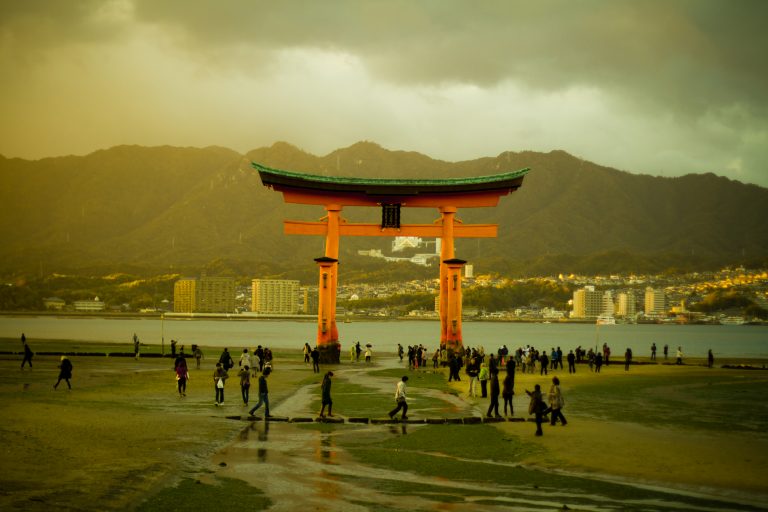
Image by Freedom II Andres/Flickr, Attribution.
The Sacred Path Is the One We’re On
A few years ago, I went into the Shinto shrine of Fushimi-Inari in the lovely city of Kyoto for the first time. It was a warm and humid summer visit to this thousand-year-old shrine, and a few of us made the pilgrimage together. A lovely spiritual guide led us through the experience. We walked mostly in silence, as one should, on this journey. We walked under thousands of torii Japanese gates that marked the path.
After about an hour of walking, I kept wondering when we would get to the shrine itself. Eventually, a little bit tired and impatient, I turned to the guide and asked, “Where is the shrine?”
He stopped, paused, and smiled in that knowing way that some guides do. With the most graceful motion, his right hand turned heavenward, he motioned his hand from right to left, pointing to everything in sight, and said: “Friend, the whole mountain is the shrine.”
It was one of those bolt-of-lightning realization kind of moments that has stayed with me even after all these years.
The whole mountain is the shrine.
It made me realize how linear my thinking had become, assuming that the path is there to bring us to a destination, and the “experience” would be had at the top of the destination. No, in this beautifully wise tradition, the whole mountain is sacred.
The torii, the Japanese gate, is said to mark the threshold between the sacred and the profane. Yet the torii is famously open. Sacred on this side, sacred on that side. Sacred to the right, sacred to the left. And while the thousands of torii do mark the path that one is encouraged to stay on, there are also hundreds if not thousands of sideway paths into other shrines, other bamboo-filled forests to wander and reflect. Ultimately, all is sacred, all is illuminated.
For the ones who walk on the path, it is all sacred.
It was The Matrix that had the memorable line:
“There’s a difference between knowing the path and walking the path.”
There are a number of signs on the path here that have stayed with me. There are reminders to “stay on the path.” And to “stay on the right path.” As a Muslim who has been raised with the opening prayer of the Qur’an, asking God to guide us to and keep us on the right path (Qur’an 1:5-6), these words are especially resonant.
There are hundreds of little shrines to the left, to the right, and on detours. Pilgrims step away, light a candle, fold their hands, and say a little prayer.
The first time I was at the shrine there were tens of thousands of pilgrims there, making it hard at times to take a single step. There was a beauty to being part of the multitudes, but I also yearn for solitude and the open spaces. So for this second visit I went back before sunrise, at four in the morning. The mountain shrine is of course open, no tickets required. You just walk the path. There is little that is required in terms of ritual, other than walking and walking under the torii gates. They are open to the left, open above, open to the right. Walking through them, you see the shrine that is the whole mountain almost like a series of moving images. But you just focus on the path. One step at a time.
How lovely would it be to treat one’s spiritual path like this: an awareness that the path is open, the path is everywhere, the path is the destination, and that what matters is to walk the path, be on the path. It is true, as the sages say, a journey of a thousand steps begins with one step.
And so I walked and walked. Listening now to the song of the birds offering their own praise. Seeing now a lake so still that the whole cosmos is reflected in it. I saw perhaps ten people in the whole two-hour pilgrimage up the mountain. The cycle of solitude would be interrupted for a few breaths by meeting a fellow seeker. Are they there to pay respect to their ancestors? To be in the mountain shrine? For exercise? I did not ask, and they did not volunteer. We simply made eye contact, silent pilgrims all of us, a subtle bow of the head, shared a smile, and kept walking…they on their path, me on mine.
Watching some of the pilgrims pause to pay respect to their ancestors also opened me up to how in our lives we are so disconnected from ancestors. If we pay attention, it is at most to parents, possibly grandparents. If we manage to rise above our own ego, we direct our compassion towards our babies. And yet how lovely to also remember those whose love and sacrifice has brought us here. We are who we are because somebody loved on us, because somebody sacrificed for us.
Watching this cycle of birth and death and reverence also attunes one to a different sensitivity. I saw under my feet a large insect (maybe a roach) being carried away for food by a whole army of ants. One death becomes sustenance for others.
The torii, the magnificent reddish-orange gates, go on and on. By some measures, there are tens of thousands of them marking the whole mountain. I paused at one point and saw that some of the torii gates themselves are in the process of decomposing. At least some of them are a cover over a tree. And the trees making up the torii gates are themselves participating in the same cycle of birth and death and return to the elements that we are. The gates marking the path decompose to the very soil that marks the path itself.
And so do we.
We are cosmic dust, spinning out of the Nothingness of pre-existence, breathed and birthed into existence by a Merciful God whose love necessitated creation. Here we stand for a few breaths, loving, yearning, seeking, finding, hoping, grieving, birthing, dreaming… and then our bodies go back into that same cosmic dust, our spirit/breaths go back to that same Loving Divine.
So let us, friends, keep walking on the path.
Let us stay on the path.
Let us follow any path that brings us to the mountaintop where Moses met God, where Jesus went, where Muhammad went to behold the Divine.
Let us remember those who loved us into being and those whom we love onto being.
Let us stay on the path and recall that the whole mountain is the path.

Share your reflection